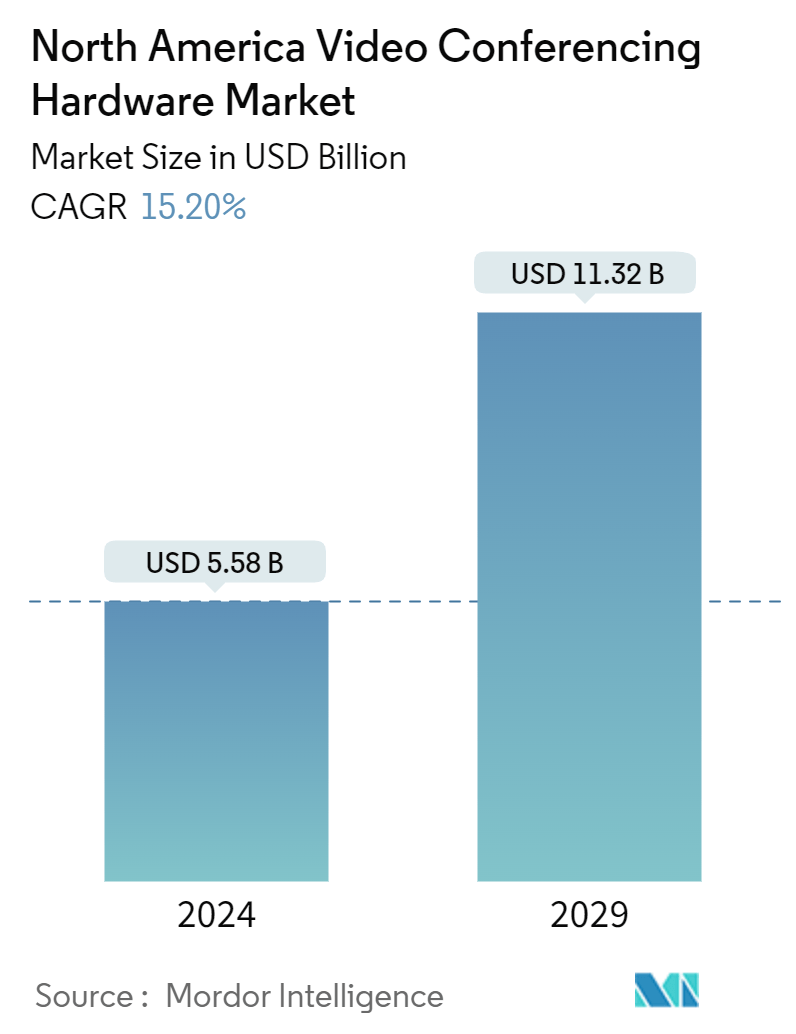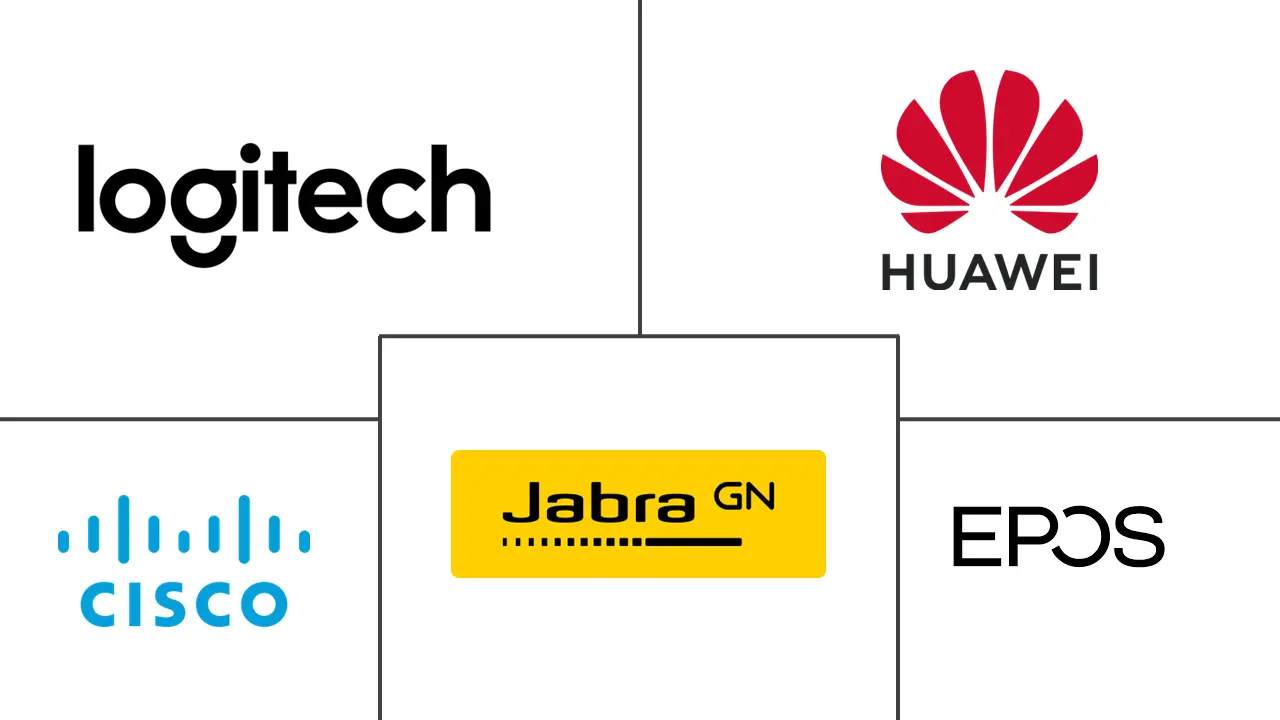Market Size of North America Video Conferencing Hardware Industry

| Study Period | 2022 - 2029 |
| Base Year For Estimation | 2023 |
| Market Size (2024) | USD 5.58 Billion |
| Market Size (2029) | USD 11.32 Billion |
| CAGR (2024 - 2029) | 15.20 % |
| Market Concentration | High |
Major Players
*Disclaimer: Major Players sorted in no particular order |
North America Video Conferencing Hardware Market Analysis
The North America Video Conferencing Hardware Market size is estimated at USD 5.58 billion in 2024, and is expected to reach USD 11.32 billion by 2029, growing at a CAGR of 15.20% during the forecast period (2024-2029).
Technological advancements in hardware such as cameras, MCUs, codec systems, enterprise headsets, and USB-based integrated bars drive the video-conferencing hardware market. The remote work or work-from-home culture of various organizations drives the demand for video conferencing hardware.
The advancement of MCUs accelerated group meetings, enabling efficient integration of inputs from various sources. MCUs ensure that each member in the video call meets the same collective feed, thus allowing efficient group communication by linking the different streams of video, audio, and data into a unified, single broadcast. Furthermore, modern MCUs integrate advanced features like transcoding that boost their potential to handle many participants with variable codec requirements bandwidth.
Cameras play a crucial role in video conferencing and remote communication in the digital world. The rising demand for remote collaboration solutions and the growth of remote work culture drive the adoption of high-resolution cameras. Prominent vendors in the camera market, such as Hikvision, Logitech, Sony, Dahua, and Huawei, are continuously investing in research and development to design innovative camera solutions with the latest technology to cater to consumer demand.
The continuous innovation and upgradation in the existing hardware create huge market opportunities. According to the Honeywell Industrial Cybersecurity USB Threat Report, in H1 2023, researchers recognized a three times rise in USB-borne malware led by two espionage campaigns that used the SNOWYDRIVE and SOGU malware variants. Both variants were spyware used to view, steal, and gain access to corporate information. To avoid such attacks, Lenovo's ThinkSmart Manager offers a USB disable option to block the USB port of conferencing devices remotely, significantly decreasing this risk and improving the device's security. Such innovations are expected to drive the market growth in the coming years.
The growth of 5G network has made it easier for people to use video-conferencing solutions, as it reduces latency and increases network speed. On the other hand, technical issues with audio/video hardware devices can limit the market growth. Low network bandwidth or connectivity issues with USB cameras/speakers/micromotes can also prevent the market from expanding. Additionally, data security issues and poor-quality audio/video or software can prevent the market from growing.
In addition, the economic slowdown and rising inflation in North America have reduced consumer spending, leading to reduced demand for video conferencing hardware and electronics products. Furthermore, the war between Russia and Ukraine hampered the global supply chain and resulted in a delay in the production of electronics products due to the unavailability of raw materials. All of these factors are likely to restrict the market growth.
North America Video Conferencing Hardware Industry Segmentation
Video conferencing hardware includes physical components and devices to facilitate practical video conferencing sessions. These tools capture, handle, and send video and audio signals among participants in a video conference. Essential hardware components in video conferencing systems usually consist of codecs or processors, collaboration bars, Multi-Control Units (MCU), Collaboration Bar Codec Systems, USB Cameras, USB-based Integrated Bars, and Other Packaged Kits.
The study tracks the revenue accrued through the sale of video conferencing hardware by various players in the North American market. The study also tracks the key market parameters, underlying growth influencers, and major vendors operating in the industry, which supports the market estimations and growth rates over the forecast period. The study further analyses the after-effects of COVID-19 and other macroeconomic factors on the market. The report’s scope encompasses market sizing and forecasts for the various market segments.
The North American video conferencing hardware market is segmented by product (multi-control units (MCU), collaboration bars, codec systems, USB cameras, USB-based integrated bars, other bundled kits, and enterprise headsets), end user (institutions and commercial spaces), and country (United States and Canada). The market sizes and forecasts are provided in terms of (USD) for all the above segments.
| By Type of Hardware | |
| Multi Control Units (MCU) | |
| Collaboration Bars | |
| Codec Systems, | |
| USB Cameras | |
| USB-based Integrated Bars | |
| Other Bundled Kits | |
| Enterprise Headsets |
| By End User | |
| Institutions | |
| Commercial Spaces |
| By Country | |
| United States | |
| Canada |
North America Video Conferencing Hardware Market Size Summary
The North American video conferencing hardware market is poised for significant growth, driven by technological advancements and the increasing adoption of remote work practices. Innovations in hardware components such as cameras, MCUs, codec systems, enterprise headsets, and USB-based integrated bars are propelling the market forward. The rise of remote collaboration solutions has heightened the demand for high-resolution cameras, with major vendors like Hikvision, Logitech, Sony, Dahua, and Huawei leading the charge in research and development. The integration of advanced features in MCUs, such as transcoding, enhances group communication by efficiently linking various video, audio, and data streams. However, challenges such as technical issues with audio/video devices, data security concerns, and economic factors like inflation and supply chain disruptions due to geopolitical events pose potential constraints to market expansion.
The market is further bolstered by the growing use of video conferencing hardware in educational institutions, where it facilitates remote learning and virtual collaboration. As hybrid learning becomes the norm, institutions are increasingly adopting these technologies to enhance student-teacher communication and support coursework progress. Key vendors are offering innovative solutions, such as Dahua Technology's DeepHub Smart Classroom Solution, to capture a larger market share. The shift towards cloud computing and mobile collaboration has made video conferencing an integral part of workforce productivity, enabling companies to reduce operational costs and adapt to a dynamic virtual marketplace. The market is dominated by leading players like Jabra, Poly, Cisco, Logitech, Huawei, and EPOS, who are actively launching new products and forming strategic partnerships to strengthen their market presence.
North America Video Conferencing Hardware Market Size - Table of Contents
-
1. MARKET INSIGHTS
-
1.1 Market Overview
-
1.2 Industry Attractiveness - Porter's Five Forces Analysis
-
1.2.1 Threat of New Entrants
-
1.2.2 Bargaining Power of Buyers/Consumers
-
1.2.3 Bargaining Power of Suppliers
-
1.2.4 Threat of Substitute Products
-
1.2.5 Intensity of Competitive Rivalry
-
-
1.3 Impact of COVID-19 Aftereffects and Other Macroeconomic Factors on the Market
-
-
2. MARKET SEGMENTATION
-
2.1 By Type of Hardware
-
2.1.1 Multi Control Units (MCU)
-
2.1.2 Collaboration Bars
-
2.1.3 Codec Systems,
-
2.1.4 USB Cameras
-
2.1.5 USB-based Integrated Bars
-
2.1.6 Other Bundled Kits
-
2.1.7 Enterprise Headsets
-
-
2.2 By End User
-
2.2.1 Institutions
-
2.2.2 Commercial Spaces
-
-
2.3 By Country
-
2.3.1 United States
-
2.3.2 Canada
-
-
North America Video Conferencing Hardware Market Size FAQs
How big is the North America Video Conferencing Hardware Market?
The North America Video Conferencing Hardware Market size is expected to reach USD 5.58 billion in 2024 and grow at a CAGR of 15.20% to reach USD 11.32 billion by 2029.
What is the current North America Video Conferencing Hardware Market size?
In 2024, the North America Video Conferencing Hardware Market size is expected to reach USD 5.58 billion.

